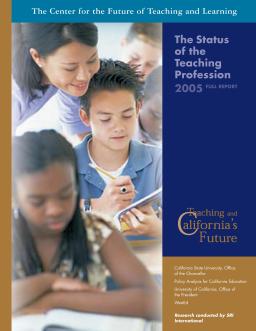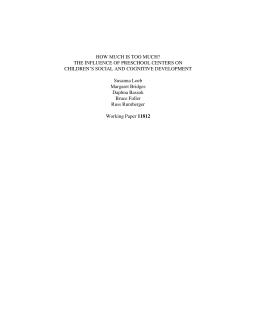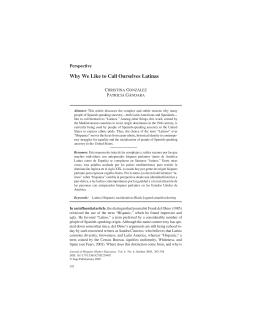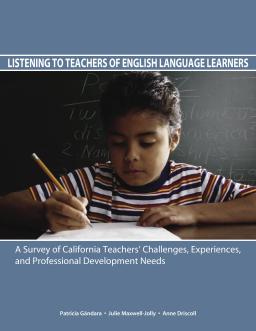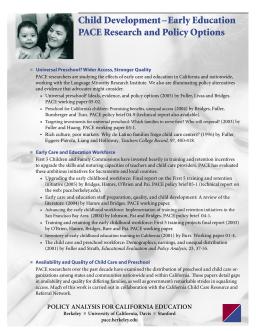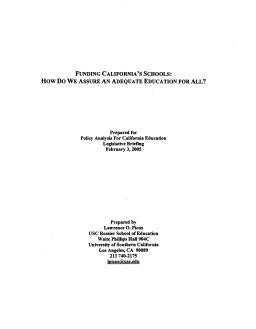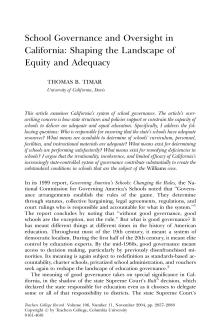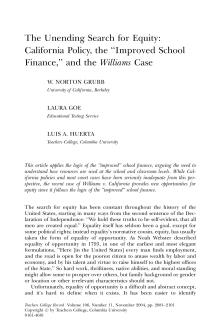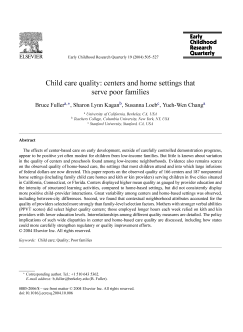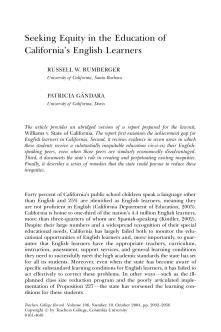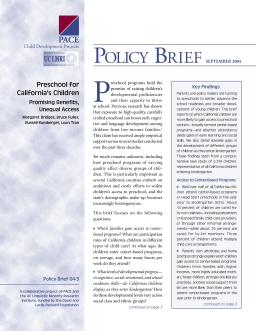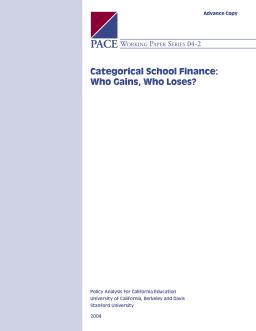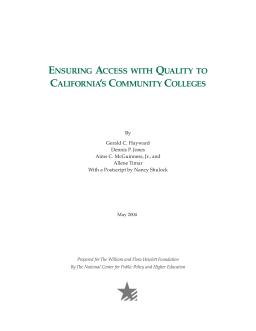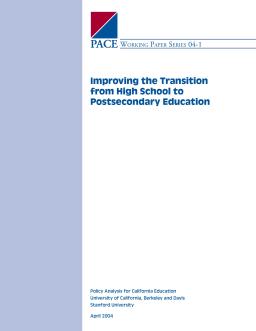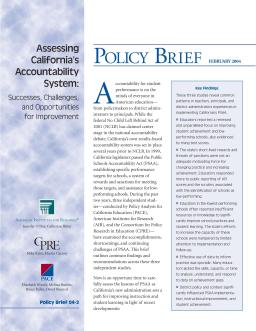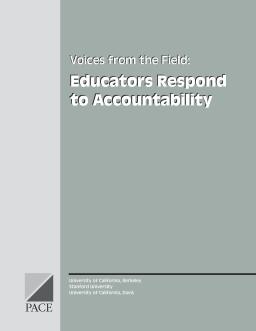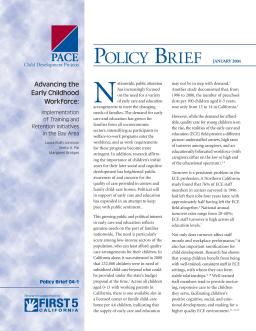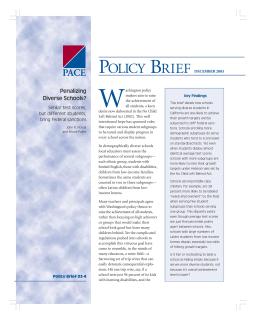Full Report
Published
Summary
The Teaching and California's Future initiative provides policymakers with data on the teacher workforce and labor market. The initiative's annual report details teacher development policies and their impact on teacher quality and distribution. The goal is to help policymakers make informed decisions about strengthening the state's teacher workforce.
The Influence of Preschool Centers on Children’s Social and Cognitive Development
Published
Summary
Using national data from the Early Childhood Longitudinal Study (ECLS-K), this study examines the association between center-based care duration and intensity and pre-reading, math skills, and social behavior of young children. Children who start center care between ages two and three see greater academic gains, while starting earlier than age two may have negative social effects. Center intensity impacts academic gains for poor and middle-income children, but not wealthier children, and negatively impacts social development for Blacks and whites but not Hispanic children.
Published
Summary
The quality of teaching and the need to expand California's ranks of excellent teachers demand urgent public discussion. We must attract the best and brightest to teaching, prepare them effectively, and support and retain them. Solutions require bipartisan leadership, not spin. This report presents the latest research and projections, highlighting that while some numbers are improving, we're likely to face severe shortages again soon and the pipeline for recruiting, preparing, and training teachers has substantial problems.
The Influence of Preschool Centers on Children’s Development Nationwide
Published
Summary
This report examines the effects of preschool or childcare exposure on cognitive and social development before kindergarten, focusing on intensity and duration of attendance, and how this varies across different income and ethnic groups. The authors utilize data from a nationally representative sample of young children with rich family background information. Findings are important for debates over extending free preschool and which groups of children would most benefit.
Published
Summary
The report explores why people of Spanish-speaking ancestry in the United States prefer to identify as "Latinos" over "Hispanics." The term "Latinos" is associated with ethnic pride and resistance against Anglo dominance, rather than a pan-ethnic historical identity. The authors argues that understanding the reasons behind this preference is important for policymakers in creating equitable policies that address the unique experiences and needs of this diverse group.
A Survey of California Teachers’ Challenges, Experiences, and Professional Development Needs
Published
Summary
This report highlights the challenges faced by English learners in California schools and the need for better implementation of policies supporting them. The authors emphasize the importance of recognizing students' diverse linguistic and cultural backgrounds and providing them with meaningful opportunities to develop their skills. They also call for more research in language assessment and bilingual education. Overall, improving outcomes for English learners is crucial for promoting equity and social justice in California's schools.
PACE Research and Policy Options
Published
Summary
PACE researchers are studying the effects of early care and education in California and nationwide, working with the Language Minority Research Institute. We also are illuminating policy alternatives and evidence that advocates might consider. Here is an infographic listing related and relevant publications.
Ideals, Evidence, and Policy Options
Published
Summary
Many California children benefit from preschooling, but enrollment rates are lower for poor and working-class families. Quality is uneven, and policy makers must address key questions regarding expanding and improving preschooling, including who should benefit and who should pay, who should operate it, how to improve quality, and how to structure it for diverse families. Evidence can inform policy options, which stem from differing ideals about preschooling. Nationwide evidence is considered in this review.
How Do We Assure an Adequate Education for All?
Published
Summary
California ranks 44th in the nation in education spending, spending only 86.1% of the national average per pupil in 2001-02. The recession of the early 2000s resulted in dramatic budget deficits for the state and substantial reductions to the expected level of school funding. Research suggests using the concept of adequacy to estimate the costs of providing an educational program that will enable all—or almost all—children to meet the state's high proficiency standards and offers recommendations for finding additional resources needed to adequately fund California's schools.
Published
Summary
The National Education Association (NEA) and the American Federation of Teachers (AFT) initially remained neutral on the No Child Left Behind Act (NCLB). Though both organizations have similar criticisms of the law, the AFT has taken a more thoughtful and less predictable approach, while the NEA has focused on public denunciation. However, neither organization has been entirely successful in crafting a policy response to NCLB.
Shaping the Landscape of Equity and Adequacy
Published
Summary
This report focuses on California's school governance system and how it affects schools' ability to provide an adequate and equal education. The author examines who is responsible for ensuring adequate resources, how to assess adequacy, how to determine school performance, and how to address deficiencies. The report argues that California's state-controlled governance system is irrational, incoherent, and limited in efficacy, contributing to substandard school conditions, as seen in the Williams v. California case.
California Policy, the "Improved School Finance," and the Williams Case
Published
Summary
This article applies the logic of the ‘‘improved’’ school finance, arguing the need to understand how resources are used at the school and classroom levels. While California policies and most court cases have been seriously inadequate from this perspective, the recent case of Williams v. California provides new opportunities for equity since it follows the logic of the ‘‘improved’’ school finance.
Centers and Home Settings that Serve Poor Families
Published
Summary
This paper analyzes the observed quality of center-based care and nonparental home settings for low-income children in five cities. The study finds that centers had higher mean quality in terms of provider education and structured learning activities, but variability existed among providers. Contextual neighborhood attributes had a stronger influence on provider quality than family-level selection factors. The policy implications of such disparities in care quality are discussed, including strengthening regulatory or quality improvement efforts.
Published
Summary
This article presents a summary of a report prepared for the Williams v. State of California lawsuit, highlighting the achievement gap for English learners in California and seven areas where they receive an inequitable education compared to their English-speaking peers. It also documents the state's role in perpetuating these inequities and proposes remedies to reduce them.
Promising Benefits, Unequal Access
Published
Summary
This policy brief examines how California's education governance has shifted from local control to centralized, administrative accountability over the past 30 years, including changes in school finance. It primarily focuses on categorical program funding, assessing its impact on equity, adequacy, flexibility, choice, efficiency, predictability, stability, rationality, and accountability. The authors also propose alternative models to the existing system of categorical funding.
Who Gains, Who Loses?
Published
Summary
Over the past 30 years, a combination of court rulings, legislative enactments, and voter initiatives has made dramatic changes in the landscape of education governance in California. The presumption of local control, a system based on local electoral accountability, has been superseded by a system of centralized, administrative accountability. Among the most sweeping changes are those that affect the way in which the state’s public schools are financed. Until 1980, paying for elementary and secondary education was largely a local matter. Local property taxes paid most of the bills. The state...
Published
Summary
This report examines the critical role played by California Community Colleges in extending college opportunity to all, as envisioned in the 1960 Master Plan for Higher Education. However, the foundation of this longstanding commitment has eroded, and renewed commitment to college opportunity is urgently needed in the knowledge-based, global economy. The report calls for action from educational, governmental, philanthropic, and civic leaders to renew and extend opportunities to shape California's future.
Published
Summary
The Bridge Project, a study of K-16 issues, presents three papers on college transition. The first finds a widespread lack of knowledge about college requirements and readiness among California students and parents. The second analyzes how students receive vague signals about academic college readiness. The third provides an example of how to improve K-16 transition and send clearer academic standards signals. Policy implications include low or no-cost recommendations to address these issues.
Early Learning Effects of Type, Quality, and Stability
Published
Summary
This report examines the effects of center care and home-based care on cognitive and social development of young children in poor communities, as well as the impact of caregiver sensitivity and education level. The study used a sample of children whose mothers entered welfare-to-work programs and found positive cognitive effects for children in center care, and stronger cognitive and social development for those with more sensitive and educated caregivers. However, children in family child care homes showed more behavioral problems.
Successes, Challenges, and Opportunities for Improvement
Published
Summary
California's accountability system, PSAA, has been examined by three independent studies, revealing five key issues. The system established specific performance targets, rewards, and sanctions for schools, but budget constraints and differences with NCLB require changes. The STAR testing and school assessment system needs review, and Governor Schwarzenegger proposed simplifying the school finance system. The brief aims to inform policymakers, clarify complex accountability issues, highlight educators' views, and outline four major implications.
Educators Respond to Accountability
Published
Summary
The Educator Responses to Accountability Project (ERAP) explores the impact of public school accountability on California teachers' and administrators' classroom practices and professionalism. State and federal policymakers support accountability, but there has been little research on local educators' experiences with such reforms. PACE conducted in-depth interviews with educators in eight elementary schools across California to understand their knowledge, understanding, and efforts to address student achievement inequities within the context of accountability.
Implementation of Training and Retention Initiatives in the Bay Area
Published
Summary
The early care and education (ECE) profession faces staffing problems due to understaffed centers, high turnover rates, and an educationally bifurcated workforce. To mitigate this issue, programs like the California Childcare Retention Incentive (CRI) provide monetary stipends to ECE professionals who meet tenure and education requirements. This policy brief summarizes findings from a two-year evaluation of CRI programs in Alameda and San Francisco counties, focusing on themes relevant to Year 2 implementation.
California’s Teaching Force, 2004—Key Issues and Trends
Published
Summary
California's aging teacher workforce will lead to a significant demand for teachers, with shortages particularly in special education and secondary education. The number of underprepared teachers in low-performing schools serving minority, poor, and ELL students is disproportionate. Budget cuts have reduced funding for recruitment and professional development programs, and California's induction system needs refinement. Curriculum-based professional development programs have mainly targeted elementary school teachers, neglecting the training needs of secondary teachers.
Similar Test Scores, but Different Students, Bring Federal Sanctions
Published
Summary
California schools with more demographic subgroups are less likely to meet their growth targets and face federal sanctions, even when students have similar average test scores. Schools with many low-income Latino students are particularly unlikely to hit growth targets. Is it fair to label diverse schools as failing when their overall achievement level is not necessarily lower?
Published
Summary
Modern statecraft in education is giving way to unmodern policy and institutional reform, favoring small and communal schools, alternative networks, and cultural pluralism. Charter schools and preschooling illuminate this shift toward de-centering education, while posing the long-term challenge of balancing particular forms of schooling against the modern impulse to integrate groups via large institutions.
